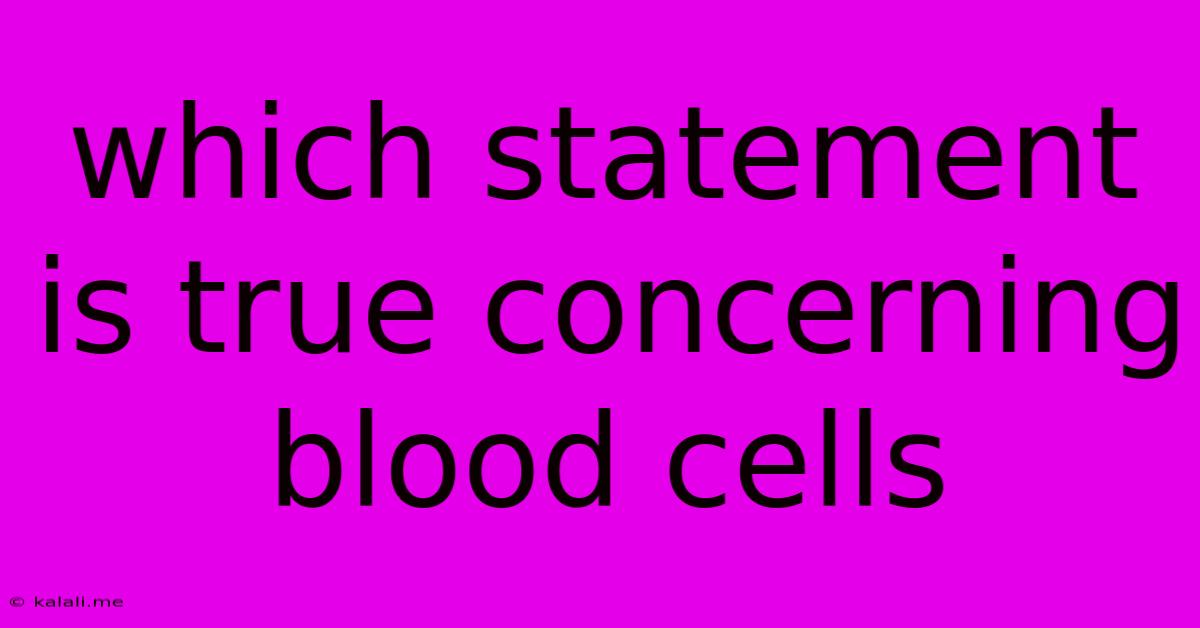Which Statement Is True Concerning Blood Cells
Kalali
Jun 15, 2025 · 3 min read

Table of Contents
Which Statement is True Concerning Blood Cells? Deciphering the Facts
This article aims to clarify common misconceptions surrounding blood cells. Understanding the different types of blood cells, their functions, and their characteristics is crucial for comprehending human physiology and various health conditions. We'll explore several statements about blood cells and determine their validity, focusing on red blood cells (erythrocytes), white blood cells (leukocytes), and platelets (thrombocytes).
Key Takeaways: This post will explore the biology of blood cells, distinguishing fact from fiction regarding their formation, lifespan, and function within the circulatory system. We'll examine the roles of erythrocytes, leukocytes, and thrombocytes in maintaining homeostasis and fighting infection. By the end, you'll have a clearer understanding of which statements accurately reflect the characteristics of these vital components of blood.
Red Blood Cells: The Oxygen Carriers
Statement 1: Red blood cells are the most abundant cells in the blood. This statement is true. Red blood cells, responsible for carrying oxygen from the lungs to the body's tissues and carbon dioxide back to the lungs, significantly outnumber other blood cell types. Their high abundance is essential for efficient oxygen transport throughout the circulatory system. Their biconcave disc shape also optimizes surface area for gas exchange.
Statement 2: Red blood cells contain a nucleus. This statement is false. Mature red blood cells in mammals, unlike most other cells, lack a nucleus and other organelles to maximize space for hemoglobin, the protein responsible for oxygen binding. The absence of a nucleus also contributes to their flexibility, enabling them to navigate through narrow capillaries.
White Blood Cells: The Body's Defenders
Statement 3: White blood cells are involved in the immune response. This statement is true. White blood cells, or leukocytes, are crucial components of the immune system. They are diverse in function, with different types targeting specific pathogens or playing roles in immune regulation. These include neutrophils, lymphocytes (B cells and T cells), monocytes, eosinophils, and basophils, each with unique roles in defending against infection and disease. Their numbers increase during infection, reflecting the body's immune response.
Statement 4: All white blood cells are the same size and shape. This statement is false. White blood cells exhibit significant variation in size and morphology depending on their type and function. For example, neutrophils are generally larger than lymphocytes and possess a multi-lobed nucleus, whereas lymphocytes have a large, round nucleus. This morphological diversity reflects their specialized roles within the immune system.
Platelets: The Clotting Champions
Statement 5: Platelets are involved in blood clotting. This statement is true. Platelets, or thrombocytes, are small, irregular-shaped cell fragments that play a critical role in hemostasis (stopping bleeding). They aggregate at the site of injury, forming a plug to seal the damaged blood vessel and initiating the coagulation cascade, leading to the formation of a stable blood clot. This process is vital to prevent excessive blood loss.
Statement 6: Platelets have a nucleus. This statement is false. Similar to mature red blood cells, platelets are anucleated cell fragments derived from megakaryocytes in the bone marrow. Their lack of a nucleus contributes to their short lifespan and their ability to readily release clotting factors.
Conclusion
Understanding the characteristics of blood cells is fundamental to understanding human health. By clarifying common misconceptions, we can build a stronger foundation for appreciating the complexity and vital roles these cells play in maintaining overall well-being. Remember that variations may exist depending on species and individual health conditions, but the core functions remain consistent. Further research into hematology and immunology will provide even more detailed insight into the fascinating world of blood cells.
Latest Posts
Related Post
Thank you for visiting our website which covers about Which Statement Is True Concerning Blood Cells . We hope the information provided has been useful to you. Feel free to contact us if you have any questions or need further assistance. See you next time and don't miss to bookmark.